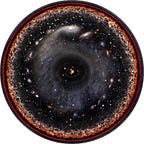“[…] is a lie which reveals the truth.”
The Artist seeks to distill their inner world, the Scientist the outer.
A terminally ill-conceived distinction, I concede, but for the purposes of this rumination; inner phenomena are those directly observable only to the individual, outer phenomena are those directly observable to multiple people.
The artist renders the inner world in the outer, where it is accessible to others. In practice, this requires compression, and thus we seek to transmit only the essence of the meanings we find in ourselves. The process of distillation does away with that which, while real, is not more relevant than it is complicating. This bears a striking resemblance to model building: idealised systems created to capture a phenomenon’s essence in order to enable understanding.
The difference between the methods we use to describe the inner and outer world can largely be ascribed to the qualities of the phenomena they entail. Loosely speaking, outer phenomena possess concreteness, specificity, and, by definition, a lack of relevant subjective meaning. Thus, the methods best suited to capturing their essence are systematic and unequivocal. I posit there is a “consonance” between phenomena and the optimal media for their investigation. That’s why the rules of the game differ between Art and Science in spite of their shared ambition.
One example in the Sciences is mathematics, “the language in which God wrote the Universe” according to Galileo. Mathematics has proven to be an astonishingly effective and versatile medium in which to encode our models of the outer world. This is because it exhibits the kind of properties which make it amenable to produce and contain these essential counterfeits (whether we have designed it as such, or it demanded to be so.)
A similar structure can be seen within the Arts, though it is more difficult to assay systematically by design. Inner phenomena are not characterisable in a general sense, this is reflected in the diversity of media employed to capture them: music, film, sculpture, dance, theatre, game, perfume, literature, photography, jewlery, calligraphy, etc. There is no limit to the amenable media for the expression of the limitlessly subjective. They are equivocal in nature precisely like the phenomena they imitate, but they nonetheless share a common function — to stir us into motion.
Whence they came they must return; their consonance with the phenomena which inspired their use must simultaneously be a consonance with that which they will inspire in turn. From the inner to the outer and back to the inner, they stand in concord with, and mediate, meaning-making; paving the way from subjectivity that took place in the past, to subjectivity that will take place in the future.
This rumination was prompted by listening to Steven Strogatz and Priya Natarajan’s foray into the topic on the ‘joy of x’ podcast, thanks to both.
There is also remarkable agreement in their relationship to truth, or falsehood rather, both maintaining kayfabe along Werner Herzog’s line:
“Instead of facts, I use the truth.”
Mathematics is only unreasonably effective insofar as music is, and rather than two cultures separated by a chasm, they are two indistinguishable absences in a cup totally-empty. This is not pessimism — the presence of the absences can be construed as magical — after all, is there a reason we should expect any effective media at all?
That’s a story for another time…
